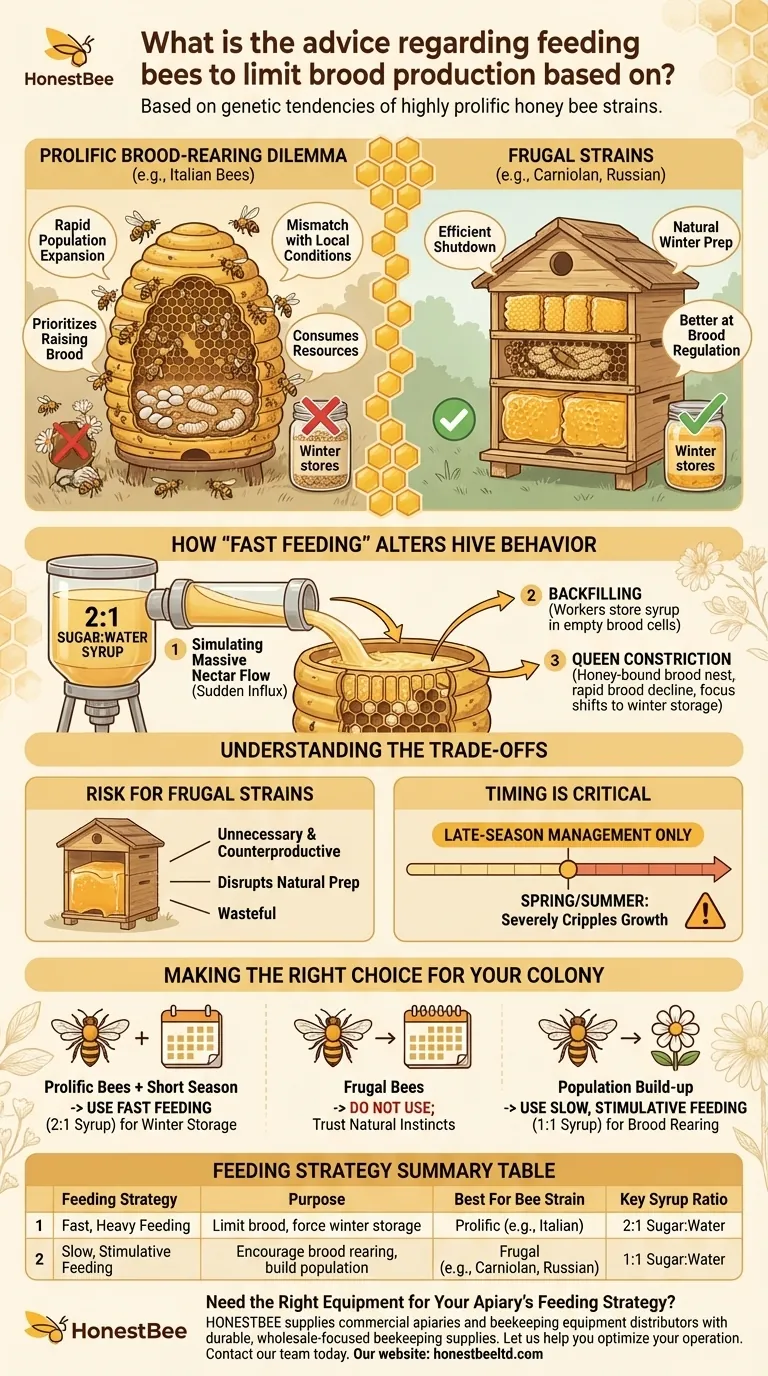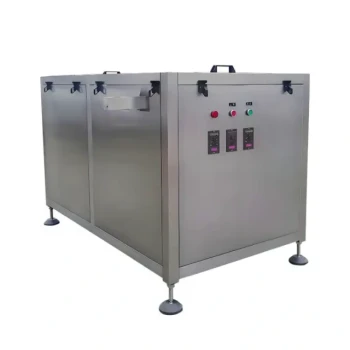This advice is specifically based on the genetic tendencies of highly prolific honey bee strains, such as Italian bees. These bees are bred to rapidly expand their population and will often prioritize raising brood over storing food, a trait that can be detrimental in certain climates.
The strategy of feeding syrup rapidly to limit brood is not a universal best practice. It is a targeted, corrective measure designed to force highly prolific bees to prioritize winter food storage over their instinct for late-season population growth.
The Prolific Brood-Rearing Dilemma
To understand the logic behind this feeding strategy, you must first understand the behavior of the bees it targets. The advice is a direct response to a specific genetic predisposition.
Understanding Prolific Strains
Certain bee subspecies, most notably Italian bees (Apis mellifera ligustica), have been selected for their ability to build up population numbers very quickly. This makes them excellent honey producers in regions with long, continuous nectar flows.
Their core instinct is to convert incoming resources—nectar and pollen—into more bees as fast as possible.
The "Brood-Centric" Strategy
Prolific bees maintain a large brood nest well into the late summer and autumn. The queen will continue laying eggs at a high rate as long as resources are coming in, assuming the flow will continue indefinitely.
This behavior ensures a massive workforce during the peak season. However, it becomes a liability when the season is ending.
The Mismatch with Local Conditions
In climates with short nectar flows or long, cold winters, this brood-centric strategy is dangerous. The colony consumes its resources raising young bees that may not live long enough to contribute, leaving insufficient honey stores to survive the winter.
The colony essentially "bets" on a long summer and loses when faced with a short one.
How "Fast Feeding" Alters Hive Behavior
The technique of feeding large quantities of syrup rapidly is a way to manipulate the bees' natural storage instincts to override their brood-rearing instincts.
Simulating a Massive Nectar Flow
Providing a large volume of heavy syrup (a 2:1 sugar-to-water ratio) in a short period—for example, a gallon in a day or two—mimics a sudden, intense nectar flow.
This is fundamentally different from slow, stimulative feeding (e.g., a 1:1 ratio offered over a week), which encourages more brood rearing.
The "Backfilling" Response
Faced with an overwhelming influx of "nectar," the bees' priority shifts to storage. They must find space for this bounty immediately.
Workers will begin to store the processed syrup in any available empty cells. This includes empty cells within the brood nest itself. This process is known as backfilling.
Constricting the Queen
As workers fill the comb with syrup, they systematically reduce the amount of open space available for the queen to lay eggs.
The brood nest becomes "honey-bound," physically restricting the queen and forcing a rapid decline in brood production. The colony is tricked into shifting its focus from expansion to winter preparation.
Understanding the Trade-offs
This technique is a powerful tool but is inappropriate and even harmful if misapplied. It is a specific solution for a specific problem.
The Risk for Frugal Strains
This strategy is generally unnecessary and counterproductive for more frugal bee strains like Carniolans or Russians. These bees are naturally better at shutting down brood production in response to shortening days and dwindling forage.
Forcing them to store excess syrup can be wasteful and disrupt their natural, and superior, wintering preparations.
Timing is Critical
This is strictly a late-season management technique. Using it during the spring or main summer nectar flow would severely cripple the colony's growth and its ability to build a strong foraging workforce.
It is intended only for when you need the colony to stop raising brood and focus entirely on storing for winter.
A Corrective Measure, Not a Standard Practice
This is not a routine procedure. It is a deliberate intervention used by beekeepers to compensate for a known genetic "flaw" of a particular bee stock in a particular environment.
Making the Right Choice for Your Colony
Your decision to use this technique must be based on your specific bees and your local climate.
- If your primary focus is managing prolific bees (like Italians) in a short-season climate: Fast feeding in the fall is a valid strategy to ensure they store enough food for winter.
- If your primary focus is managing frugal bees (like Carniolans or Russians): You should not use this technique; trust their natural instincts to regulate the brood nest for winter.
- If your primary focus is building colony population for pollination or a spring flow: You should use slow, stimulative feeding (1:1 syrup), which has the opposite effect and encourages brood rearing.
Ultimately, effective beekeeping comes from matching your management techniques to the specific genetics of your bees and the realities of your environment.
Summary Table:
| Feeding Strategy | Purpose | Best For Bee Strain | Key Syrup Ratio |
|---|---|---|---|
| Fast, Heavy Feeding | Limit brood, force winter storage | Prolific (e.g., Italian) | 2:1 Sugar:Water |
| Slow, Stimulative Feeding | Encourage brood rearing, build population | Frugal (e.g., Carniolan, Russian) | 1:1 Sugar:Water |
Need the Right Equipment for Your Apiary's Feeding Strategy?
Whether you manage prolific Italian bees requiring rapid late-season feeding or frugal Carniolan strains that thrive on natural cycles, having reliable, high-capacity equipment is key to success. HONESTBEE supplies commercial apiaries and beekeeping equipment distributors with durable, wholesale-focused beekeeping supplies—from heavy-duty feeders to hive components designed for efficient colony management.
Let us help you optimize your operation. Contact our team today to discuss bulk pricing and tailored solutions for your specific bee stock and climate challenges.
Visual Guide

Related Products
- Rapid Bee Feeder White Plastic 2L Round Top Feeder for 8 or 10-Frame Bee Hives
- HONESTBEE Advanced Ergonomic Stainless Steel Hive Tool for Beekeeping
- High Quality Honey Dehumidifier Dryer Thickening Machine for Beekeeping
- Professional Dual-End Stainless Steel Hive Tool for Beekeeping
- Portable Uncapping Tank Holder Uncapping Bench for Beekeeping
People Also Ask
- How much honey does a strong hive need to survive winter? Ensure Your Colony's Survival (60-80 lbs)
- What are the recommended sugar-to-water ratios for making sugar syrup for bees? Optimize Your Hive's Health
- Can sugar syrup contaminate the honey crop? A Beekeeper's Guide to Protecting Honey Purity
- What is the best thing to feed bees? A Guide to Supplemental Feeding for a Thriving Hive
- How do you set up and use a top feeder for bees? A Step-by-Step Guide for Safe Feeding



















